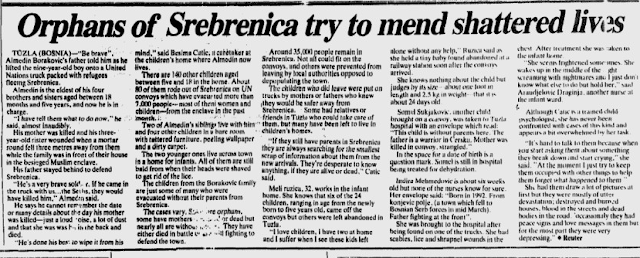ORPHANS OF SREBRENICA TRY TO MEND SHATTERED LIVES
The Indian Express, p.6
29 April 1993.
TUZLA, Bosnia-Herzegovina — “Be brave,” Almedin Borakovic’s father told him as he lifted the nine-year-old boy onto a United Nations truck packed with refugees fleeing Srebrenica.
Almedin is the eldest of his four brothers and sisters aged between 18 months and five years, and now he is in charge.
“I have told them what to do now,” he said, almost inaudibly.
His mother was killed and his three-year-old sister wounded when a mortar round fell three metres away from them while the family was in front of their house in the besieged Muslim enclave.
His father stayed behind to defend Srebrenica.
“He is a very brave soldier. If he came in the truck with us… the Serbs, they would have killed him,” Almedin said.
He says he cannot remember the date or many details about the day his mother was killed — just a loud noise, a lot of dust and that she was killed in the back and died.
“He’s done his best to wipe it from his mind,” said Besima Catic, a caretaker at the children’s home where Almedin now lives.
There are 140 other children aged between five and 18 in the home. About 80 of them rode out of Srebrenica on UN convoys which have evacuated more than 7,000 people — most of them women and children — from the enclave in the past month.
Two of Almedin’s siblings live with hin and four other children in a bare room with tattered furniture, peeling wallpaper and a dirty carpet.
The two younger ones lives across town in a home for infants. All of them are still bald from when their heads were shaved to get rid of the lice.
The children from the Borakovic family are just some of many who were evacuated without their parents from Srebrenica.
The cases vary. Some are orphans, some have mothers wounded or dead, but nearly all are without fathers. They have either died in battle or while fighting to defend the town.
Around 35,000 people remain in Srebrenica. Not all could fit on the convoys, and others were prevented from leaving by local authorities opposed to depopulating the town.
The children who did leave were put on trucks by mothers or fathers who knew they would be safer away from Srebrenica. Some had relatives or friends in Tuzla who could take care of them, but many have been left to live in children’s homes.
“If they still have parents in Srebrenica, they are always searching for the smallest scrap of information about them from the new arrivals. They’re desperate to know anything, if they are alive or dead,” Catic said.
Meli Ruzica, 32, works in the infant home. She knows that six of the 24 children, ranging in age froom the newly born to five years old, came off the convoys but others were left abandoned in Tuzla.
“I love children, I have two at home and I suffer when I see these kids left alone without any help,” Ruzica said as she held a tiny baby found abandoned at a railway station soon after the convoys arrived.
She knows nothing about the child but judged by its size — about one foot in length and 2.5 kg in weight — that is about 24 days old.
Sanel Suljakovic , another child brought on a convoy, was taken to Tuzla hospital with an envelope which read: “This child is without parents here. The father is warrior in Cerska. Mother was killed in convoy, strangled.”
In the space for a date of birth is a question mark. Sanel is still in hospital being treated for dehydration.
Indira Mehmedovic is about six weeks old but none of the nurses know for sure. Her envelope said: “Born in 1992. From Konjevic Polje. (a town which fell to Bosnian Serb forces in mid March). Father fighting at the front.”
She was brought to the hospital after being found on one of the trucks. She had scabies, lices and shrapnel wounds in the chest. After treatment she was taken to the infact home.
“She seems frightened sometimes. She wakes up in the middle of the night, screaming with nightmares and I just don’t know what else to do but hold her,” said Araudjelovic Draginja, another nurse at the infant ward.
Although Catic is a trained child psychologist, she has never been confronted with cases of this kind and appears a bit overwhelmed by her task.
“It’s hard to talk to them because when you start asking them about something they break down and start crying,” she said. “At the moment I just try to keep them occupied with other things to help them forget what happened to them.”
She had them draw a lot of pictures at first but they were mostly of otter devastation: destroyed and burned houses, blood in the streets and dead bodies in the road, occasionally they had peace signs and love messages in them but for the most part they were very depressing.” (Reuter)



<< Home